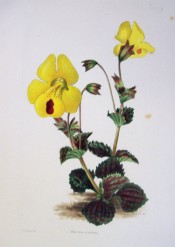Mimulus luteus L.
Fully-hardy, vigorous, spreading perennial with yellow flowers with dark red to purple-red spots on the throat from late spring to summer. To 30cm by 60cm. [RHSE, Hortus].
Horticultural & Botanical History
According to Johnson’s Dictionary Mimulus luteus was introduced to Britain in 1826 but it was probably earlier. ‘There are several hybrids reared from the seeds of this species, which vary much in the colour and size of the flowers, some of which are very showy.’ [Don]. Curtis's Botanical Magazine suggests that Mimulus luteus was first grown at the Cambridge Botanic Garden under the name M. Langsdorfii, but this plant is almost certainly Mimulus guttatus. [BM t.1501/1812]. [See Mimulus guttatus DC.]. There was still doubt about the status of M. guttatus as a species in 1864, Curtis's Botanical Magazine commenting on M. luteus var. cuprea, there figured, that it is ‘only one of the many varieties of M. luteus, along with guttatus, smithii and many others.’ [BM t.5478/1864]. Two garden varieties are listed by Johnson's Dictionary, rivularis Lind. and younganus. The variety rivularis is figured in the Botanical Register, shown with yellow flowers, spotted bright red in the throat, and with a large red blotch on the lower petal. [BR f.1030/1827]. Loddiges’ Botanical Cabinet also figures rivularis [LBC no.1575/1831], and the Floricultural Cabinet figures Mimulus rivularis var. youngii, said to be a hybrid between rivularis and variegatus, shown with yellow flowers with dark purple tips to the petals. [FC p.218/1833]. In addition to these Paxton's lists Wilsoni, a hybrid with yellow spotted flowers, introduced in 1836, and Flore des Serres figures a number of varieties of M. luteus. [FS f.857/1854]. ABR pl.661/1814.
History at Camden Park
Listed in all published catalogues [H.146/1843]. A number of seedlings of unspecified species or hybrids of Mimulus were obtained from the Sydney Botanic Garden on 17th October 1853. [RBGS AB].
Notes
Florists’ Mimulus
Mimulus were popular Victorian plants but of the plants described in the Hortus only the hybrids and cultivars of Mimulus luteus can be regarded as true Florists’ flowers:
‘I imagine that, ere long, this genus will occupy a much more general and conspicuous position in the green house and flower garden than it does at present. By suitable management the varieties of M. rivularis, and other true hybrids, with their extremely rich crimson belts and spots, on a clear yellow or orange ground, may be found to furnish a very desirable contrast with the numerous dark tints and colours of the Cineraria tribe during the early spring months.’ [Gard. Chron. 1852]. ‘Petals thick and velvety texture, the turn-over portion to be large, circular, and conceal the divisions; colours bright or dense, ground all alike in shades, blotches well defined, plant dwarf, flowers abundant, and mouth upwards, to show the inside.’ [FC p.10/1848]. ‘Many years ago I imposed upon myself the task of raising Mimulus to the rank of a Florist’s flower.’ The writer, A. Clapham of Scarborough, then gave detailed instructions which would enable any amateur to ‘feel confident that, at a very trifling cost of labour, he can raise still handsomer seedlings than the beautiful varieties that I have had the pleasure of introducing to the public. The properties of a good Mimulus are robustness of habit, with a tendency to profuse blooming. The flowers should be large, raised in the centre, and of good substance, possessing a short tube and a wide throat. Three distinct shades of colour ought always to be visible on the light varieties.’ [Gard. Chron. 1852].
Published Jan 29, 2009 - 03:40 PM | Last updated Sep 05, 2011 - 02:58 PM
| Family | Scrophulariaceae |
|---|---|
| Category | |
| Region of origin | Chile |
| Synonyms | |
| Common Name | Monkey musk, Yellow monkey flower |
| Name in the Camden Park Record | Mimulus luteus
|
| Confidence level | high |
